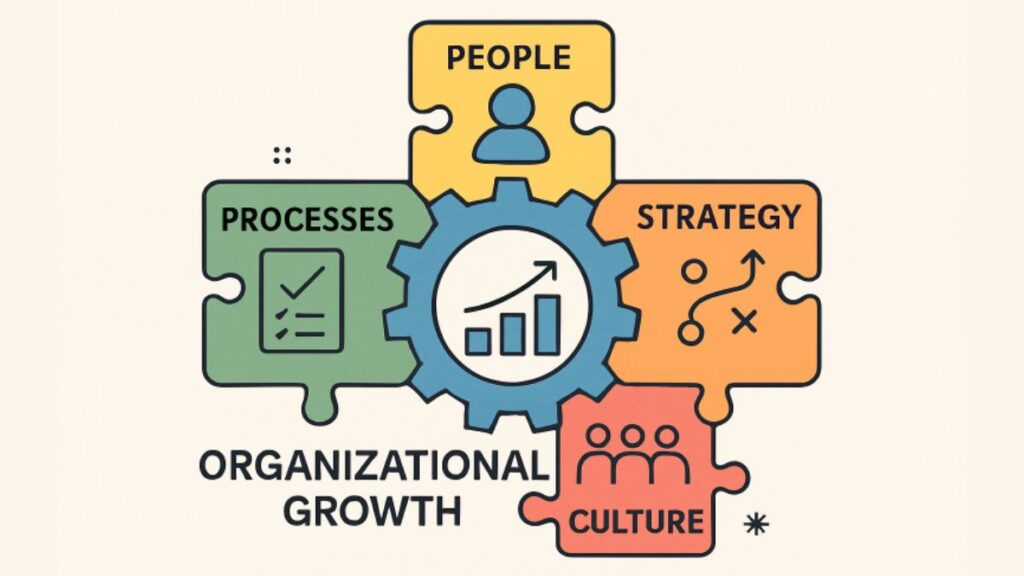Scaling an organization in today’s dynamic business environment is a complex process that demands more than just ambition—it requires a multi-pronged, strategic approach. Effective scaling involves well-structured planning, empowered leadership, robust systems, and a focus on the vitality and culture of the workforce. Integrating expert partners, such as Navalent organizational consulting, can offer tailored solutions for navigating rapid expansion and organizational transformation. Successful companies recognize the importance of striking a balance between innovation and managerial discipline, effectively weaving together the strengths of people, processes, and strategic vision.
The pursuit of growth can test every facet of a business, from strategy and leadership to technology and employee well-being. Scaling is not just about increasing headcount or market share; it is about building an organization that can sustain success, adapt to change, and foster resilience along the way. Alignment between leadership, teams, and culture is crucial to ensure that growth does not outpace the organization’s foundational strengths. By leveraging expertise in organization design, teams can streamline operating models and reduce friction during expansion. Effective scaling also involves adapting systems to new realities, embracing change at every level, and keeping employee engagement at the heart of strategic decisions.
Strategic Planning for Sustainable Growth
Foundational to any scaling initiative is a robust and adaptive strategic plan. According to the Harvard Business Review, organizations that regularly revisit and adapt their strategies outperform those with static plans, especially in changing economic conditions. The strategic plan should be aspirational yet grounded, setting long-term objectives alongside short-term milestones that keep everyone moving forward together. This includes not just growth targets, but also risk mitigation and contingency plans to respond to unexpected market shifts.
Modern organizations are increasingly leveraging ecosystem approaches, partnering with and integrating complementary businesses to build value networks. These collaborations can boost innovation, fill capability gaps, and reduce time-to-market as new opportunities emerge. Strategic planning must also account for agility—the ability to pivot quickly and effectively without losing sight of the core mission. Leading organizations continuously scan the market, adjust priorities, and communicate intent across all layers to ensure clarity of direction.
Leadership Development in Scaling Organizations
Scaling puts leadership to the test, requiring individuals at all levels to evolve from managing small teams to addressing the complexities of larger, interconnected operations. Effective leaders inspire confidence and provide clear direction during periods of change and uncertainty. According to McKinsey & Company, organizations that prioritize leadership development outperform peers in growth and profitability, attributing much of their success to robust internal pipelines for future leaders.
Leadership programs that incorporate coaching, mentorship, and scenario-based training help develop skills directly relevant to scaling efforts. Systemic team coaching, in particular, encourages leaders to break down silos, foster trust, and build shared accountability. The competencies required at scale—such as critical thinking, decision-making, empathy, and adaptability—ensure that executives can guide teams through each phase of organizational transformation. This high-performance leadership culture becomes a multiplier, amplifying the capabilities of every individual within the company.
Cultivating a Collaborative Culture
A collaborative culture is the cornerstone of any organization striving for sustainable growth and scaling—high-trust environments where information and ideas are shared openly, fueling innovation and speeding problem-solving. Forbes outlines how cross-functional collaboration propels creativity and agility, enabling companies to respond nimbly to change. By designing structures and incentives that reward teamwork—rather than competitiveness—organizations create conditions for spontaneous collaboration and continuous learning.
This kind of culture doesn’t happen by accident. Intentional design is critical, including regular feedback loops, open forums, and tools that facilitate seamless communication across departments. One notable example is Airbnb’s journey in aligning design and engineering teams, which not only improved product consistency but also accelerated feature delivery across platforms. Leaders must model collaborative behaviors and embed knowledge sharing into the organization’s core values so that these behaviors scale alongside headcount and market expansion.
Implementing Scalable Systems and Processes
As organizations scale, so does the need for efficient systems and agile processes. Implementing cloud-based technologies, project management tools, and data-driven decision-making platforms enables companies to maintain visibility and coherence during periods of rapid growth. According to TechCrunch, businesses that invest in scalable infrastructure early can adapt more smoothly when facing surges in demand or geographic expansion.
It’s not enough to automate existing workflows; scaling often requires a reimagining of core processes for greater flexibility and efficiency. Agile methodologies, lean management, and continuous process optimization help organizations stay responsive and innovative amidst growth. These operational enhancements eliminate bottlenecks, empower teams to self-organize, and ensure resources are allocated where they drive the most value. The “Scaling Up” model emphasizes the importance of striking a balance between strategic vision and disciplined execution.
Prioritizing Employee Well-Being
Rapid scaling can place significant strain on employees, risking burnout and disengagement if well-being is not prioritized. The World Economic Forum identifies employee well-being as a critical driver of both resilience and long-term performance. Organizations that create positive work environments, offer holistic support, and maintain open lines of communication can preserve engagement and productivity during times of change.
Holistic well-being strategies include regular feedback cycles, flexible work arrangements, and investment in mental health resources. Leaders should ensure well-being is embedded in policies, not just perks, and that it aligns with overall business objectives. By evolving well-being programs to meet the changing expectations of employees, organizations foster loyalty and sustain the momentum needed for lasting growth.
Conclusion
Sustainable scaling is a continuous journey that demands strategic foresight, empowered leadership, a collaborative culture, and resilient systems—all underpinned by a steadfast commitment to employee well-being. By integrating these holistic strategies, businesses of all sizes can position themselves for resilient and adaptable growth in an ever-changing marketplace.






